Options for Homeowners
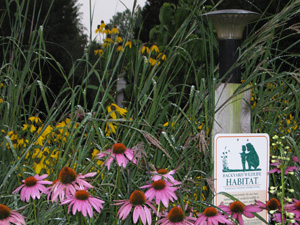
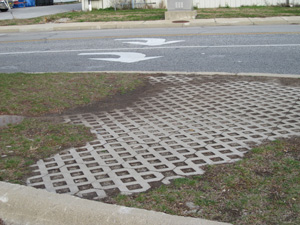
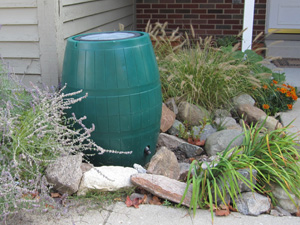
As a resident in the Blue River area, you can do a number of things around your home to improve water quality. Expand the accordions below for information about local resources and suppliers. All of these items will help the hellbender.
Information about Rain Barrels
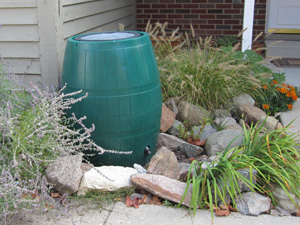
You can use water collected in rain barrels to water your vegetables, lawn, and flowers while reducing your utility bills. Depending on your house and yard size, you can collect a significant amount of rainfall using your rain barrels. Estimates indicate during a one inch rain event, one downspout delivers 12 gallons of water per minute and that one rain barrel will save 1,300 gallons of water throughout the year. With rising municipal water rates and increasing drought concerns throughout the region, harvesting your own water through rain barrels is becoming more and more important and appealing.
Rain water collection in barrels or other vessels is an ancient and traditional practice that is both efficient and economical. Rain barrels do more than save money--they can help protect the environment. Every time it rains, water gushes from your downspouts across your lawn into local streets picking up pesticides, sediment, and nutrients before flowing into local storm drains. Once in the storm drain system, polluted runoff is carried directly to the Blue River. Installation of a rain barrel can reduce the flow of polluted runoff from your property during the first flush of rain. The more water you retain on site, the less water flows across the land surface resulting in less sediment and nutrient polluted runoff flowing directly into the Blue River.
Find more information on rain barrels view Rainscaping Education Program. You will also find resources with options for sustainable landscape design and management practices that prevents polluted runoff from reaching water bodies - directing stormwater to be absorbed by plants and soils.
Information about Rain Gardens

Rain gardens provide an attractive solution to water ponding and yard drainage issues. In urban and suburban settings, rooftops, roadways, and other paved surfaces cause water to move quickly across their surfaces. This increased rate of flow reduces the ability for water to soak into the ground and reach the groundwater system. Using these shallow depressions planted with native plants reduces the amount of water on the surface of your lawn and slowly filters water as it moves into the ground. Rain gardens are also pretty and inviting to wildlife such as butterflies and birds and are nearly maintenance free once established.
Native plants filter rain water removing sediment and nutrient pollutants from runoff. Every time it rains, water gushes from your downspouts across your lawn into local streets picking up pesticides, sediment, and nutrients before flowing into local storm drains. Depending on the slope of your lawn, rain may cause ponding or wetspots within your yard. Once in the storm drain system, polluted runoff is carried directly to the Blue River. Installation of a rain garden can reduce the flow of polluted runoff from of your property during the first flush of rain allowing water to slowly move into the groundwater system. The more water you retain on site, the less water flows across the land surface resulting in less sediment and nutrient polluted runoff flowing directly into the Blue River.
Find more information and resources view the Purdue Extension Rainscaping Education Program website along with resources for sustainable landscape design and management practices that prevents polluted runoff from reaching water bodies - directing stormwater to be absorbed by plants and soils.
Information about Green Roofs
 Green roofs provide insulation reducing heat lost through a traditional roof and decreasing the need for air conditioning throughout hot months. The reduction in heating and cooling costs can be significant depending on the size of the green roof compared to the overall size of the building roof. Green roofs can also increase the lifespan of a building’s roof by protecting structural elements from UV rays, wind and temperature; increase agricultural space; reduce noise; and increase real estate resale value. Although installation costs are higher than traditional roofs, if properly maintained green roofs will last longer than traditional roofs resulting in lower costs over the long-term.
Green roofs provide insulation reducing heat lost through a traditional roof and decreasing the need for air conditioning throughout hot months. The reduction in heating and cooling costs can be significant depending on the size of the green roof compared to the overall size of the building roof. Green roofs can also increase the lifespan of a building’s roof by protecting structural elements from UV rays, wind and temperature; increase agricultural space; reduce noise; and increase real estate resale value. Although installation costs are higher than traditional roofs, if properly maintained green roofs will last longer than traditional roofs resulting in lower costs over the long-term.
Plants, including those installed as part of a green roof, filter rain water removing sediment and nutrient pollutant from runoff. Every time it rains, water moves across traditional roofs picking up any sediment, nutrients, metals or other materials deposited on the surface of the roof. Water moves from your roof into your downspout and out into the storm drain. Once in the storm drain system, polluted runoff is carried directly to the Blue River.
Installation of a green roof can reduce up to 95% of the volume of polluted runoff from your property. The more water you retain on site, the less water flows across the land surface resulting in less sediment and nutrient polluted runoff flowing directly into the Blue River. Additionally, green roofs absorb pollutants from the air filtering these before releasing dissolved oxygen into the air and provide habitat for insects and birds.
Information about Pervious Pavement
 Pervious pavement can be used for driveways, parking areas, sidewalks, road shoulders, boat ramps, and as part of decks or patios. Pervious pavement is thicker than traditional pavement; however, installation costs are lower resulting in an overall savings using pervious pavement. Pervious pavement requires no expansion to accommodate water moving through or across the pavement. This means that plants and weeds observed on traditionally-paved surfaces don’t occur in pervious pavement. Additionally, the light gray color associated with pervious concrete (one type of pervious pavement) reduces the amount of heat reflected from the paved surface on sunny days. On rainy days, pervious pavement reduces puddling and icing.
Pervious pavement can be used for driveways, parking areas, sidewalks, road shoulders, boat ramps, and as part of decks or patios. Pervious pavement is thicker than traditional pavement; however, installation costs are lower resulting in an overall savings using pervious pavement. Pervious pavement requires no expansion to accommodate water moving through or across the pavement. This means that plants and weeds observed on traditionally-paved surfaces don’t occur in pervious pavement. Additionally, the light gray color associated with pervious concrete (one type of pervious pavement) reduces the amount of heat reflected from the paved surface on sunny days. On rainy days, pervious pavement reduces puddling and icing.
Pervious pavement is designed to allow polluted runoff to move through the paved surface into the soil surface below. Under typical rain conditions, 3 to 8 gallons of water per minute can move through each square foot of pervious pavement. Once water reaches the soil surface, the water is naturally filtered and pollutants are removed. Normal pavement forces water to run across its surface picking up sediment, nutrients, pesticides, herbicides and any other materials sitting on the pavement’s surface. Once this polluted runoff reaches the storm drain system, all of these pollutants are carried directly to the Blue River. By using pervious pavement, you can help keep the Blue River free from these pollutants.
Information about Native Plants
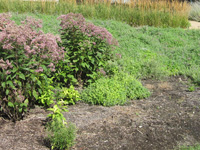 Native plants require less maintenance, less water, and provide better soil stability than non-native plants. Because native plants originated in this region, they are adapted to the climatic conditions, including temperature, wind speed, sunlight, and rainfall that occur within the region. These adaptations allow native plants to thrive under the conditions present here. Typically, that means saving money on water bills and saving time pruning, weeding, and transplanting. Plants native to this region have long root structures providing more soil stability and maintaining better plant structure. This means that your native plants will come back year after year with minimal time and energy input from you.
Native plants require less maintenance, less water, and provide better soil stability than non-native plants. Because native plants originated in this region, they are adapted to the climatic conditions, including temperature, wind speed, sunlight, and rainfall that occur within the region. These adaptations allow native plants to thrive under the conditions present here. Typically, that means saving money on water bills and saving time pruning, weeding, and transplanting. Plants native to this region have long root structures providing more soil stability and maintaining better plant structure. This means that your native plants will come back year after year with minimal time and energy input from you.
Native plants provide better soil stability thereby reducing soil erosion. They are also adapted for the Blue River community and interact better with insect, bird, and other wildlife populations providing greater biodiversity and long-term sustainability. Plants that evolved in this region are adapted for the dry summers, cold winters, and wet springs and falls. They thrive under these conditions without coddling and provide nourishment and habitat to native wildlife present within the community.
Native Seed Sources
- Ion Exchanger, Harpers Ferry, IA, 800-291-2143 www.ionxchange.com
- Star Seed, Beloit, KS, 785-738-5775 nativeseedgroup.com
- Oak Prairie Farms, Pardeeville, WI, 800-894-3884
- Spence Restoration Nursery, Muncie, IN, 765-286-7154 www.spencenursery.com
- Ernst Conservation Seeds, Meadville, PA, 800-873-3321 www.ernstseed.com
- Prairie Moon Nursery, Winona, MN, 866-417-8156 www.prairiemoon.com
- Stock Seed Farms, Murdock, NE, 402-867-3771 www.stockseed.com
- JFNew, Walkerton, IN, 574-586-3400 www.cardnonativeplantnursery.com
- Roundstone Native Seed, LLC, Upton, KY, 270-531-2353
- Applegate’s Seed House formerly AgVenture D&M, Brook, IN, 219-275-6755
- Osenbaugh Grass & Wildflower Seeds, 800-582-2788
- Byron Seeds LLC/ Weaver Seeds, Marshall, IN 800-801-3596
Information about Planting Native Trees
 Trees provide shade that helps regulate home temperatures, resulting in reduced heating costs in the winter and cooling costs in the summer. On average, residences with properly placed trees experience 27% lower summer costs and 15% lower winter costs. Properties which contain quality tree canopies are valued 5 to 15% higher than properties which lack trees. Furthermore, properties adjacent to parks are valued 8 to 20% higher than homes located elsewhere. Additionally, research suggests that trees help reduce crime rates.
Trees provide shade that helps regulate home temperatures, resulting in reduced heating costs in the winter and cooling costs in the summer. On average, residences with properly placed trees experience 27% lower summer costs and 15% lower winter costs. Properties which contain quality tree canopies are valued 5 to 15% higher than properties which lack trees. Furthermore, properties adjacent to parks are valued 8 to 20% higher than homes located elsewhere. Additionally, research suggests that trees help reduce crime rates.
Trees absorb air and water pollutants, filtering ozone, nitrogen dioxide, sulfur dioxide, and carbon dioxide from the air and nutrients and pesticides from the water. It is estimated that one mature deciduous tree can catch over 5,000 gallons of rainwater per year. The US Forest Service estimates, a city needs to increase its tree canopy by 10-15% to counteract the extra runoff created by an extra 1% of hard surfaces. Trees, therefore, can have a significant, positive impact on the environment and reduce the money needed for stormwater control. During photosynthesis, trees take in carbon dioxide from the air and release oxygen while their leaves trap and hold pollutants like dust and smoke. Annually, a healthy tree stores 13 pounds of carbon. Mature trees remove up to 70 times the amount of pollution from the air as that removed by young trees. Trees also filter chemicals and sediment from runoff, hold soil in place, reduce polluted runoff over soil by holding water in their leaves and bark, and absorb and block noise and unsightly views – all of which helps reduce the flow of polluted water into the Blue River.
Information about Bioswales
 Native vegetation planted in an open channel are more attractive than concrete or rock-lined channels. Bioswales require less maintenance than traditional hard-structure channels as the permeable surface allows water to move through the system into the groundwater system rather than flooding surrounding areas or sitting on the hard surface. The lack of ponding also limits freeze-thaw issues, surface cracking, and weed growth through the hard surface.
Native vegetation planted in an open channel are more attractive than concrete or rock-lined channels. Bioswales require less maintenance than traditional hard-structure channels as the permeable surface allows water to move through the system into the groundwater system rather than flooding surrounding areas or sitting on the hard surface. The lack of ponding also limits freeze-thaw issues, surface cracking, and weed growth through the hard surface.
Bioswales are designed to remove sediment, nutrients, metals, and other pollution from surface waters. Bioswales slow the flow of water allowing water to reach the groundwater system rather than staying in the storm drain system. The roots of the plants house useful organisms that convert the pollutants into plant growth. Water is also captured by the plants themselves and used in plant growth. All of these features contribute to less polluted water entering the Blue River.
Information about Backyard Wildlife Habitats
 Functional backyard wildlife habitats include three things: food, water, and cover. Provision of food and cover typically includes planting native vegetation on which local wildlife can thrive and incorporating thickets, shrubs, trees, and other vegetation. The sustainable gardening practices encouraged by the Natural Wildlife Federation’s Certified Wildlife Habitat Program encourages practices that hold water on your property, encourage the transfer of water from the surface water system, and often incorporate many of the practices identified as ways to Help the Hellbender.
Functional backyard wildlife habitats include three things: food, water, and cover. Provision of food and cover typically includes planting native vegetation on which local wildlife can thrive and incorporating thickets, shrubs, trees, and other vegetation. The sustainable gardening practices encouraged by the Natural Wildlife Federation’s Certified Wildlife Habitat Program encourages practices that hold water on your property, encourage the transfer of water from the surface water system, and often incorporate many of the practices identified as ways to Help the Hellbender.
Native plants, native trees, green roofs, rain gardens, and bioswales all provide food and cover for wildlife, while rain gardens and rain barrels can be used to supply water for wildlife. Organizations such as the National Wildlife Federation and Indiana Wildlife Federation have certification and recognition programs for homeowners and businesses who create functional backyard wildlife habitats. See more information about those programs in the links below:
National Wildlife Federation Backyard Habitat Certification
